What is UX Strategy? With Frameworks, Books and Examples.
UX design is about users. Or is it?

“Don’t make me think!” - Steve Krug’s first law of usability
User experience design strives to create an outstanding experience for the users of your website or web app. But there is more to it. Your company has one or more products, a business plan, employees working in several departments, and various other stakeholders, too.
UX design affects all these other aspects of your business and vice versa. To balance all those aspects, you need a strategy.
Unlock the full potential of your UX design with a solid UX strategy.
Talk to us about finding the sweet spot between meeting your users' goals and driving your business forward.
Do you have a UX Strategy?
Your UX strategy influences everything you do to create a tailored experience for your users. Whether you are designing the user experience for your website, your web app, or any other touchpoints on the customer journey, a sound UX Strategy should be the foundation of your UX process. An articulated strategy keeps all stakeholders on the same page, and creates a North Star on which to base all your decisions.
To get clear about the strategy of your site, start with two fundamental questions:
What do your users want from your website?
A primary goal of UX design is to help your website visitors get their job done. Whether they’re looking for information or to solve a problem, they should be able to get what they need without effort. Satisfied users turn into happy and loyal customers.
What does your business want from your website?
The goals of a business typically differ from the goals of its customers. Does the company want to make more money (for example, by selling more products), or save money (for example, by reducing the number of support tickets per week)? Or is the goal to increase brand awareness? In any case, a successful business aligns goals with its users’ goals to achieve a win-win situation.
Find the intersection of these two sets of goals - the UX sweet spot.
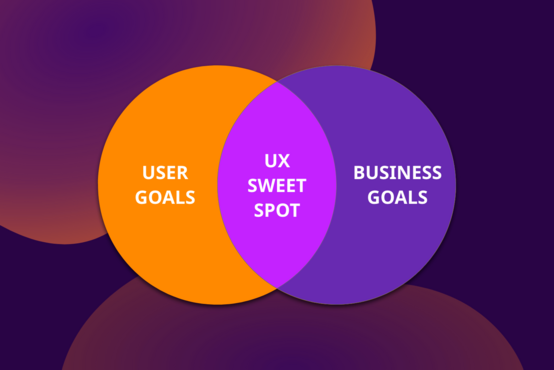
This step is difficult but necessary as well as exciting. In what ways do the business goals overlap with the user goals? Which user goals support which business goals, and vice versa? Distill these goals from the mass of unrelated business and user goals, and you have found your sweet spot.
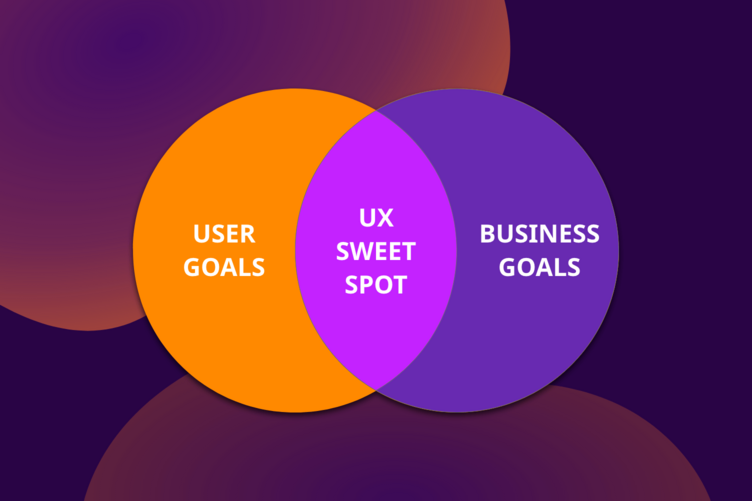
What is UX Strategy, and how does it relate to UX design?
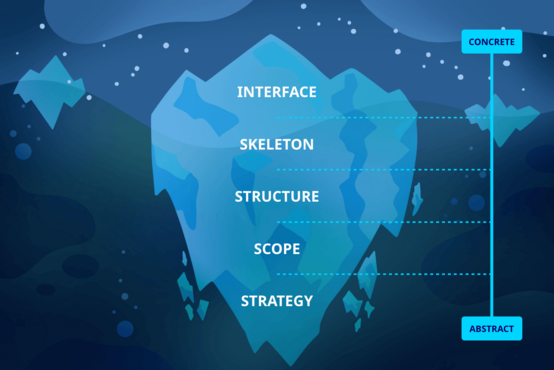
So far, we talked about the necessity of a sound UX strategy, but what is a UX strategy comprised of?
In “The Elements of User Experience,” author Jesse James Garrett defines a framework based on five planes that build upon each other.
The base plane is UX strategy. This is your overarching plan for creating a positive and coherent user experience that aligns with your business objectives. At the strategy level, you need to understand your users’ goals and needs, as well as your business goals. What are your users’ pain points, and how do your offerings help address those pain points?
This plane is the foundation for all higher planes: scope, structure, skeleton, and surface. These planes move the focus toward the design process. Each plane gets a bit more specific and adds details to the design. Moving through these planes, UX design implements your UX strategy by defining the site structure, site navigation, and visual elements, to bring the strategy to life.
The takeaway: Good UX design takes the insights gained from the UX strategy to create a product with an outstanding user experience for the target audience and great support of the business objectives.
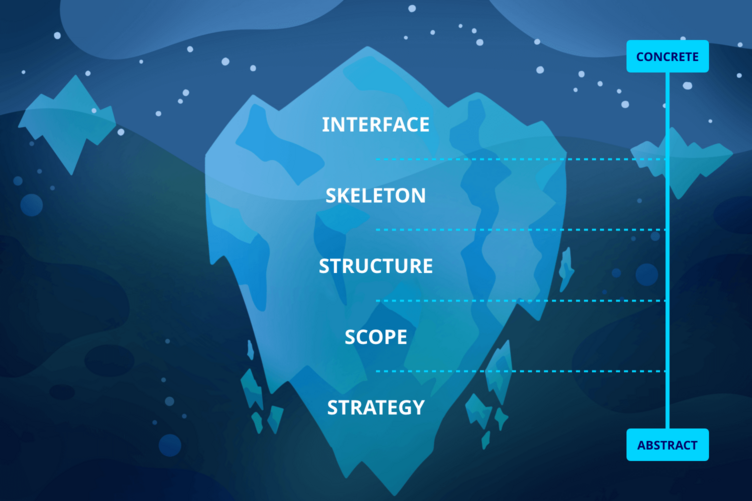
A good UX Strategy has numerous benefits
Each of the above steps takes time and resources, which is why some UX teams are tempted to skip the strategy process and jump straight into UX design. Do this at your own peril. A sophisticated UX strategy can lead to solutions that save more time and resources through the investigation and planning of a mature UX vision.
- Clear goals: Have you ever worked towards a goal, only to discover that it was the wrong one? A UX strategy is like a golden thread that can show you the way.
- Lucid users: The lack of a strategy can lead to inconsistent user experience. With a common strategy, all the different points of user contact can align their UX.
- Amplification of user engagement: A UX design without a clear strategy can prevent users from reaching their goals. Next time, they might look elsewhere. Keep your UX design clear and useful by adhering to the strategy.
- An efficient site: Ad-hoc UX design with no clear scope and structure makes navigation tedious and searching difficult. Remember the five-planes model: Strategy is the foundation that supports clear scope, structure, skeleton, and surface.
- Sustainable design: A design without consistency quickly becomes hard to maintain. A clear strategy leads to consistent and maintainable design across all customer touchpoints.
- Accessibility solutions: Inconsistent UX design may severely affect accessibility. Any good UX strategy should have accessibility as one of its goals.
There is no such thing as a perfect recipe for creating a UX Strategy (but there are UX Strategy frameworks)
UX strategy is not an exact science. A UX strategy framework is not a recipe that you can blindly follow – it is a guide that helps you build a strategy tailored for your needs.
Despite the clear necessity of a strong UX strategy, there are only a handful of true UX strategy frameworks available. General strategic frameworks like Design Thinking can be used to fill the gap, but a framework specifically tailored for UX may yield better results.
Here are two example frameworks to try on for size:
Example framework – Jaime Levy’s four tenets of UX strategy
In the book “UX Strategy”, Jamie Levy lays out a UX strategy framework that defines the four tenets of a good UX strategy:
Business Strategy + Value Innovation + Validated User Research + Frictionless UX
- Business Strategy: “The top-line vision of the company. It ensures the long-term growth and sustainability of the organization.”
- Value Innovation: “Align newness with utility and a lower cost structure to the benefit of the customers and stakeholders.”
- Verified User Research: “Verify that you’re on the right track with understanding your potential or existing users’ goals and needs.”
- Frictionless UX: “Interfaces and user flows should be geared toward successful outcomes. It’s all about simplicity, engagement, and the practical usefulness of the product.”
(All citations above are taken from the book: UX Strategy: Product Strategy Techniques for Devising Innovative Digital Solutions by Jaime Levy.)
These tenets interact with and affect each other. They do not deliver a precise recipe to follow, and are not intended to. In Jamie Levy’s words,
“UX strategy is an empirical practice. It’s not a means of formulating and executing a perfect plan; rather, it’s about being able to research what’s out there, examine the opportunity space, test hypotheses, fail, learn, and iterate until you devise something of value that people truly want. You will need to take risks and accept failure. You’ll learn how to fail smartly by doing rapid experiments to validate that your strategy is moving your team in the right direction.”
Example framework – b13’s seven stages of a successful UX strategy
At b13, we describe the development of a UX strategy as a 7-step process. Each step collects new information and unlocks insights to be used in the next step.
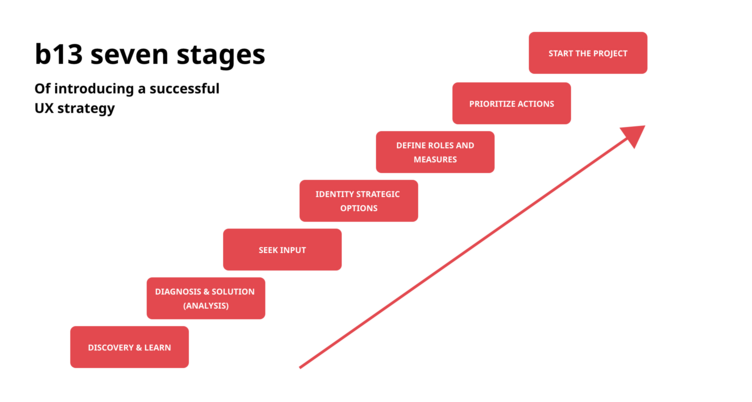
1. Discover & Learn - Gathering Information
The goal of discovery is to collect as much useful data as possible.
The discovery process covers different aspects and facets of the status quo.
- Build a Business Model Canvas to get a bird’s-eye view of your business.
- Develop customer personas to know your typical customers better.
- Do a competitive analysis to determine how your offers can stand out.
- Include the “boring but important” base data—company performance, KPIs, and other key metrics.
Always keep your existing business strategy in mind. Ensure that your UX strategy aligns with the business strategy.
2. Diagnosis & Solution - Analysis
Data is nothing without analysis. Take the data from the discovery step and x-ray it. Think “SWOT”: What are your business’s strengths, weaknesses, opportunities, and threats? Do you need to re-align your strategic positioning?
Also, start looking at your current user experience and identify discrepancies with the UX strategy that you are about to form and refine.
3. Seek input
Now it is time to review the strategy from different angles. With the company vision and mission in mind, collaborate with other stakeholders to define specific problems and objectives from their particular perspectives. Tap into their knowledge and viewpoints.
4. Identify strategic options - Strategic planning
At this point, you should have enough data at hand to go into the planning phase. In UX strategy meetings, all stakeholders can discuss their visions of the UX strategy and work out a strategic roadmap.
5. Define roles and measures
The next step is to get into the details. Based on the roadmap, define UX KPIs and deliverables, and communicate them to all involved teams.
6. Prioritize actions
Before heading into the project phase, ensure you have clear outcomes defined. Break down the deliverables into actions. Prioritize the actions and estimate the efforts for each, to get a reasonable timeline for the project.
7. Start the project
Now you’re ready. Go ahead and start the project!
Build a better user experience with a strong UX strategy
UX Strategy brings business and customers together. It is the foundation for all UX design decisions and influences the steps and outcomes in the design process. Without a solid UX strategy, all UX design remains fragmented and benefits neither your users nor your business.
When customers approach b13 for doing a UX design project, we work closely with them to ensure their UX strategy gets turned into exceptional UX design. We ensure that your UX design reflects the essence of your customer’s UX strategy.
Want to learn more about how b13 can integrate your UX strategy into the design process?
Get in touch!
